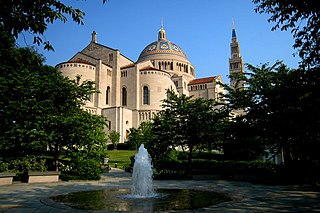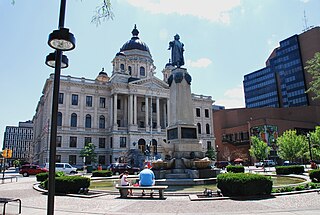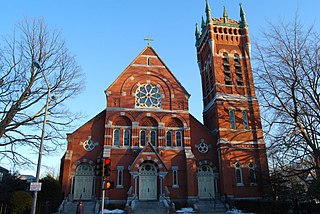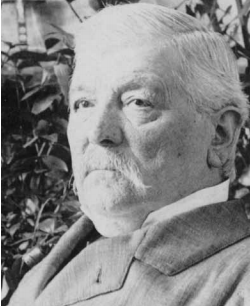
Maginnis & Walsh was an architecture firm started by Charles Donagh Maginnis and Timothy Francis Walsh in 1905. It was known for its innovative design of churches in Boston in the first half of the twentieth century.

The Pontifical College Josephinum is a Roman Catholic seminary and private university in Columbus, Ohio. It was founded by Joseph Jessing in 1888 and was granted the status of a Pontifical College in 1892 by Pope Leo XIII, making it the only pontifical seminary in North America. Although the college is accredited by the Higher Learning Commission (HLC) and Association of Theological Schools in the United States and Canada (ATS), both accreditors placed the institution on probation in 2022 for issues including problems in strategic planning, internal leadership structures, and declining enrollment.

The Diocese of Columbus is a Latin Church ecclesiastical territory, or diocese, of the Catholic Church covering 23 counties in central Ohio in the United States. It is a suffragan diocese in the ecclesiastical province of the metropolitan Archdiocese of Cincinnati.

John Joseph Jessing a German-American immigrant, who became a Catholic priest in the United States, and was a pioneer in Catholic orphanage work and Catholic education. He was also the founder of the Pontifical College Josephinum in Columbus, Ohio, in 1888.

Patrick Charles Keely was an Irish-American architect based in Brooklyn, New York, and Providence, Rhode Island. He was a prolific designer of nearly 600 churches and hundreds of other institutional buildings for the Roman Catholic Church or Roman Catholic patrons in the eastern United States and Canada, particularly in New York City, Boston and Chicago in the later half of the 19th century. He designed every 19th-century Catholic cathedral in New England. Several other church and institutional architects began their careers in his firm.

Columbus Circle is a neighborhood and plaza in the downtown section of Syracuse, New York, United States. At the center of the circle is a large fountain and the Columbus Monument, designed by the Syracuse-born architect Dwight James Baum and dedicated in 1934. Columbus Circle is home to Syracuse's two cathedrals, the Episcopalian St. Paul's Cathedral and the Roman Catholic Cathedral of the Immaculate Conception, as well as the Onondaga County Courthouse and the John H. Mulroy Civic Center.

The Diocese of Wagga Wagga is a Latin Church suffragan diocese of the Archdiocese of Sydney, established in 1917, covering the Riverina region of New South Wales in Australia.

Patrick W. Ford (1847–1900) was an Irish-American architect who, along with Patrick C. Keely of Brooklyn and James Murphy of Providence, Rhode Island designed many Roman Catholic churches built in the eastern part of United States through the latter half of the 19th century.

The Diocese of Victoria is a Latin Church ecclesiastical territory or diocese of the Catholic Church in the Canadian province of British Columbia. Its episcopal see is in Victoria. The diocese encompasses all of Vancouver Island and several nearby British Columbia islands. A suffragan diocese in the ecclesiastical province of the metropolitan Archdiocese of Vancouver, the diocese's cathedral is St. Andrew's Cathedral and its present diocesan bishop is Gary Gordon.

Josep Llimona i Bruguera was a Spanish sculptor. His first works were academic, but after a stay in Paris, influenced by Auguste Rodin, his style drew closer to modernisme. He was very prolific, and exhibited in Catalonia, Madrid, Paris, Brussels and Buenos Aires. Some of his monumental work is familiar to Barcelona residents and visitors alke.

Charles Edward McDonnell was an American prelate of the Roman Catholic Church. He served as Bishop of Brooklyn from 1892 until his death in 1921.

Parque Colon, or Columbus Park, is the central square of the Ciudad Colonial historic district of Santo Domingo, Dominican Republic. In its center stands a statue of Christopher Columbus, in whose honor the square was renamed in 1887. Previously the square was known as Plaza Mayor.
Edward Gerard Hettinger was a bishop of the Catholic Church in the United States. He served as auxiliary bishop of the Diocese of Columbus from 1942 to 1977.

Luigi Gregori (1819–1896) was an Italian artist who worked at the Vatican and served as artist in residence and professor at the University of Notre Dame.
Aloïs De Beule was a Belgian sculptor.
Charles H. Pizzano, born Ciriaco Pizzano, was a sculptor from Medford, Massachusetts, with work featured around the United States.

A statue of Christopher Columbus was installed in Christopher Columbus Waterfront Park, in Boston's North End, in the U.S. state of Massachusetts. On June 11, 2020, the statue was removed for an undisclosed period after it was decapitated by protestors on the evening of June 9, 2020 during the George Floyd protests.

A statue of Christopher Columbus was installed in Richmond, Virginia in 1927, where it stood until 2020 when it was torn down by protestors in the wake of the murder of George Floyd and thrown into a nearby lake.

A statue of Christopher Columbus was installed in Pioneer Park, San Francisco, California.

















